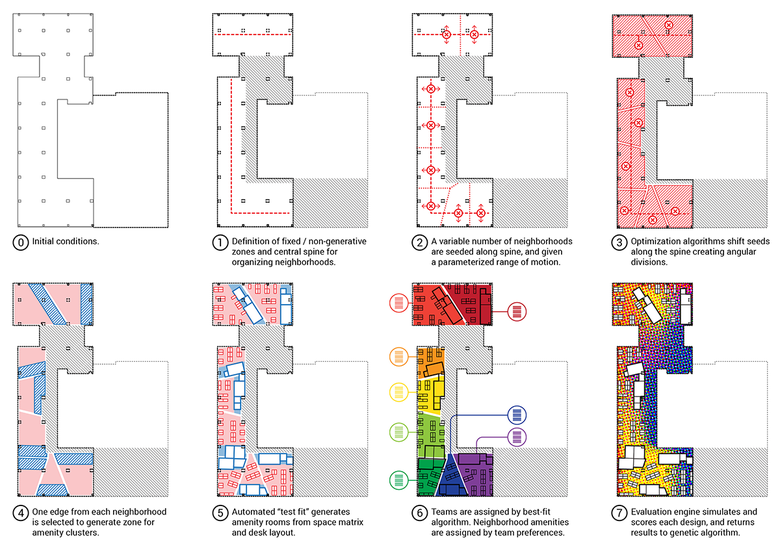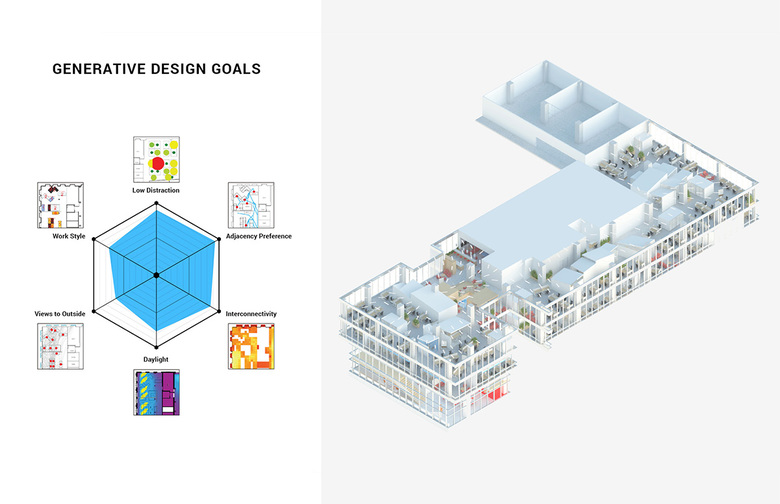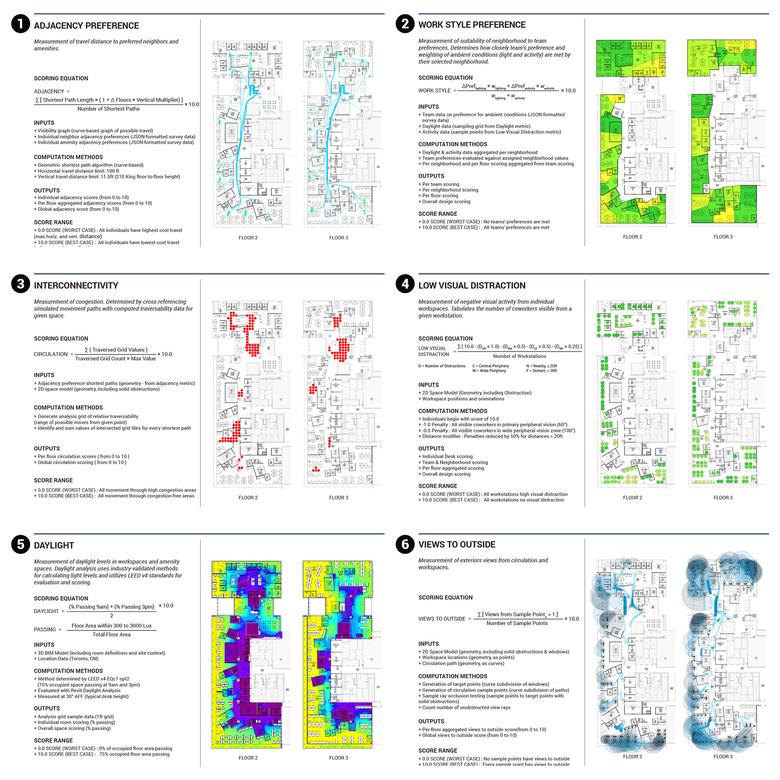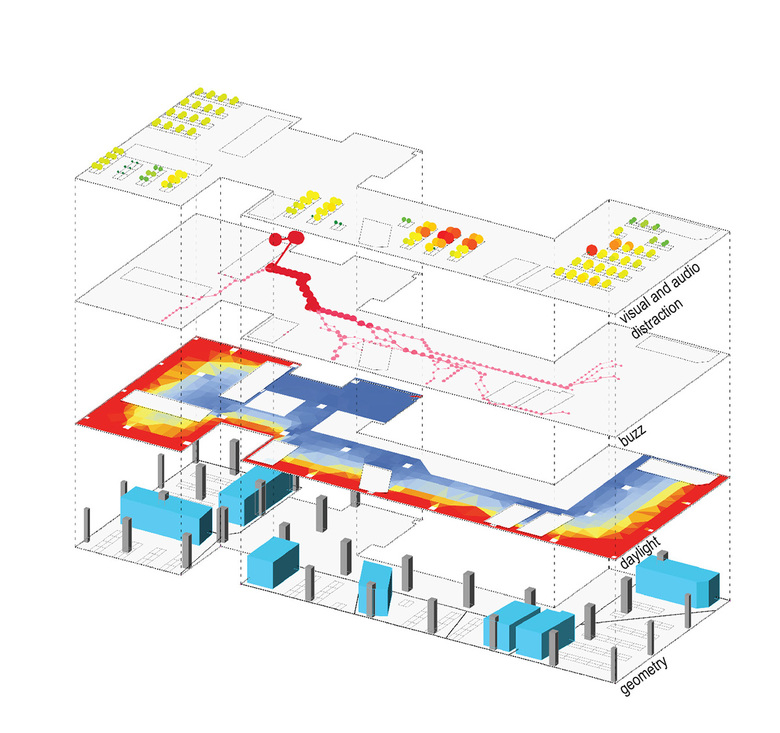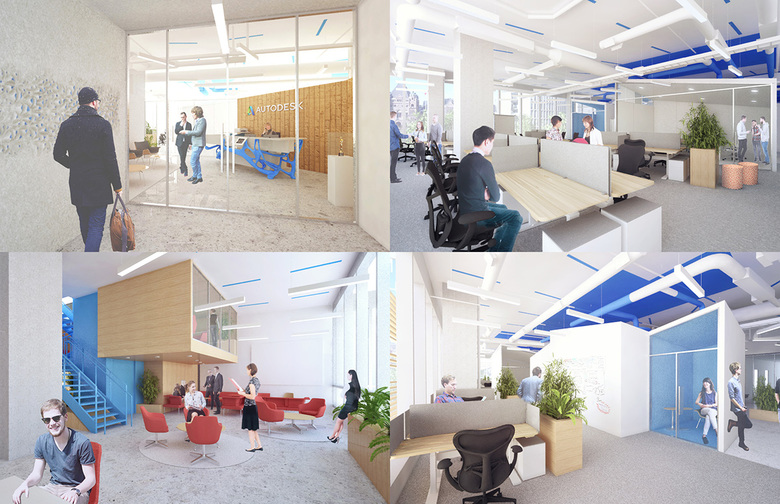The Promise of Generative Design
Marc K. Howe
5. April 2017
MaRS Generative Design: design options (All images courtesy of Autodesk)
From CAD to BIM, 3D printing, and virtual reality, technology's influence upon architectural production is pervasive and increasingly rapid. Much talk of the next big thing focuses on generative design. But what is it and how will it impact architects? Marc K. Howe spoke with Danil Nagy of Autodesk Research Group's The Living, which is at the forefront of generative design, about the potential of generative design software and how it is being used on one particular project.
Computational design promises to have a profound, far-reaching impact upon the architecture profession by automating the creation of bespoke building plans that solve specific project challenges. The latest generative design software developed by companies such as Autodesk is capable of independently producing customized architectural plans free of any further human interaction following the setting of initial parameters and the launch of programs. Architects can adjust the software to produce an endless slew of architectural designs that satisfy the specific criteria associated with a given project in terms of cost, constructibility or performance dynamics, at a pace and level of productivity that would be impossible for human beings to match.
MaRS Generative Design: description of specification of geometric model
According to Danil Nagy, designer and senior research scientist with Autodesk Research Group’s The Living, generative design programs can play a critical role in helping architects resolve the practical challenges encountered during the design process, such as creating spatial layouts that are more conducive to pedestrian traffic or help to foster colleague interaction, or maximizing exposure of building occupants to daylight and exterior views.
"The starting point for our use of generative design was trying to determine which aspects of the architectural design process were the most complex and difficult for humans to think through, and figuring out how to get a computer to work them out for us," said Nagy. "It’s all about isolating those very tricky practical issues, and then using a computer to automate the development of solutions for those problems."
MaRS design metrics, left to right: adjacency preference, work style preference, buzz, productivity, daylight, and views to outside
An outstanding example of the tremendous potential of generative design as a problem-solving design tool is Autodesk’s development of a new office and research space in Toronto’s MaRS Innovation District. One of the key goals in developing the new office and research space was the creation of a spatial layout that would foster happenstance interaction between the diverse range of talent setting up shop in the MaRS district.
"Our focus was on space planning – we wanted people to travel easily around the office, yet we also wanted to create these zones of congestion where people could interact and meet with each other," said Nagy. "We developed the architectural concept of breaking up shared spaces into amenities zones that in turn break up the office."
MaRS Generative Design
The researchers realized that generative design was an ideal means for solving the practical hurdles associated with this innovative design mandate. "Once we had the concept, the design task was to arrange all these spaces in the office to basically maximize certain design aspects of the office and minimize some of the difficulties," said Nagy. "We felt that this kind of space planning was the perfect opportunity for the generative design process."
The use of generative design in tandem with modern computing power enabled the researchers to attack the design challenge with a level of intensity that would have been impossible for human beings to replicate: "You can go through the feedback loop of sketching out a design and then testing it yourself maybe just a few times. The computer can iterate through that process extremely quickly, so in this case we did 10,000 design options in just a few days. The computer can then evaluate each one and tell us which ones it thinks are the best. Human architects can then evaluate them on the basis of subjective factors such as aesthetics."
MaRS date collection illustration
In addition to solving vexing practical challenges, generative design could also raise the efficiency and economy of the overall development process by producing designs that improve scheduling and coordination between multiple stakeholders. "There are major potential savings from an efficiency standpoint for the actual building process, because architecture isn’t just about designing the vision of a building in a computer - it’s also about interfacing with contractors," said Nagy. "A lot of efficiency and cost gains come from the scheduling of construction, and coordinating the process of actually getting things built. Generative design could be used to maximize construction efficiency or budget efficiency once other stakeholders like clients and contractors are brought into the design process."
MaRS Generative Design goals
While computational design has the potential to bring myriad benefits to the development process, some observers have expressed deep misgivings about its potential negative impacts. A commonly voiced concern is that computational design could have the same impact upon the architecture profession that automation has wrought in other sectors of the economy, achieving dramatic efficiency and cost gains at the expense of human personnel. According to Nagy, however, members of the architectural profession need not fret about the potential impact of computational design upon their livelihoods, given the indispensable role that human beings play in making decisions with respect to style, aesthetics and the way the interior space of a building is directly experienced by occupants.
MaRS Generative Design goals
At the end of the day architecture is an artistic as well as a practical discipline, and uniquely human faculties are still needed to determine if a particular design is satisfactory or pleasing from an aesthetic perspective. For Nagy generative design is about empowering architects as opposed to making them obsolete, by giving them the ability to access virtually endless design options that resolve the practical challenges of projects. "After the generative design process, architects still have to go through the suite of design options generated and look at them using their own intuition to pick the best one," said Nagy.
MaRS Generative Design simulation
The emergence of generative design does mean, however, that the role of the architect itself will change, and members of the profession will need to expand their skill sets in order to take full advantage of the tremendous power offered by the latest computational tools. According to Nagy, "We talk about this technology as more of an augmented or collaborative process, and as it develops architects will need a new set of skills to take advantage of them. You’re not just designing the spaces, you’re also designing the way that you interact with the computer to explore all those different options."
MaRS Generative Design renderings
For this reason Nagy expects programming knowledge to become an indispensable component of the architectural skill set. "At the cusp of innovation, architects will have to know how to program, and we’re already seeing this," he said. "I teach at Columbia GSAPP, and part of the standard curriculum for all incoming architecture students is scripting and programing. You will have to engage with the computer on its own terms, because if we want to use the potential of computers to help us through a design problem we need to be able to present that problem to the computer in its own language. That’s why in future computer programming will be a fundamental skill for architects."
Danil Nagy
Marc K. Howe is a Canberra-based industry and business journalist who has written extensively about the Australian AEC sector.

